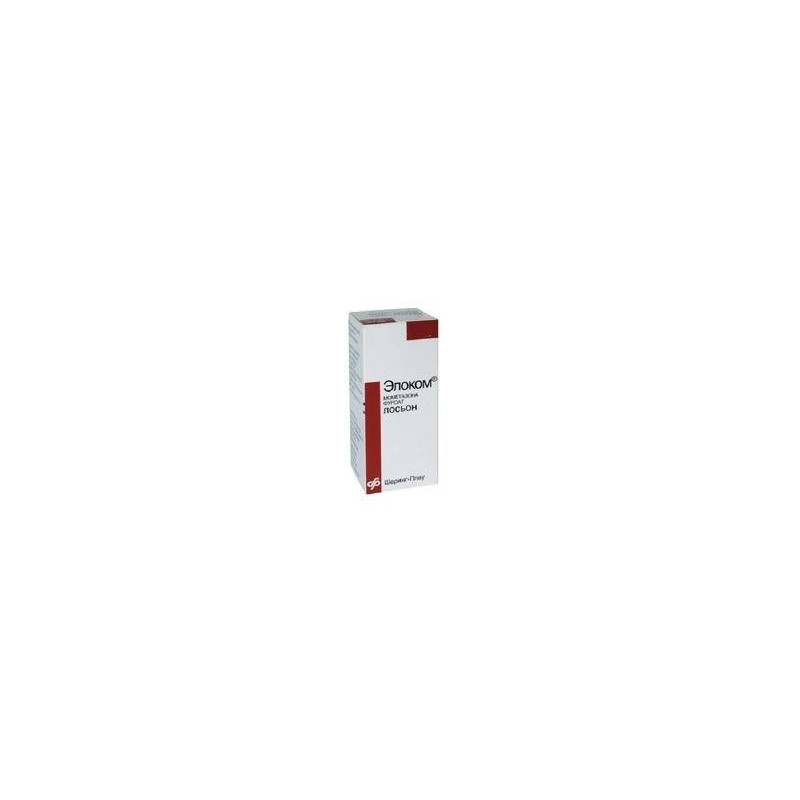



 All payments are encrypted via SSL
All payments are encrypted via SSL
 Full Refund if you haven't received your order
Full Refund if you haven't received your order
Lotion
1 ml contains mometasone furoate 1 mg
Bottle of 30 ml.
Elocom is a synthetic non-fluorinated glucocorticoid for external use.
Mometasone furoate - highly active GCS, has anti-inflammatory, antiexudative, antipruritic action. The mechanism of action is not completely installed. GCS is suggested to induce the release of lipocortins (phospholipase A inhibiting proteins2), which control the biosynthesis of such potent inflammatory mediators, such as prostaglandins and leukotrienes, by releasing their precursor arachidonic acid.
Weakening and elimination of inflammatory reactions and itching in dermatoses sensitive to GCS therapy in adults and children aged 2 years and older.
Hypersensitivity to the components of the drug and other corticosteroids.
The safety of using Elocom during pregnancy has not been studied, so the use of the drug is possible only in cases where the intended benefit to the mother outweighs the potential risk to the fetus; you should not use the drug in high doses and use it for a long time.
It is not known whether mometasone is excreted in breast milk. Apply Elocom during lactation should be with caution.
Lotion in the amount of a few drops is applied to the affected skin (including the scalp) 1 time / day and rubbed with soft movements until completely absorbed.
Local reactions: when applying the cream is very rare - burning, itching, skin atrophy; when applying lotion rarely - burning, folliculitis, acne, rash, itching; when applying the ointment rarely - burning, itching, tingling, tingling, furunculosis. The use of ointments and creams in some cases reported the appearance of rosacea. In controlled studies in children aged 2 to 12 years with the use of cream and ointment (n = 74), the incidence of adverse events (burning, itching, furunculosis) was 7%.
Other: hypertrichosis, hypopigmentation, perioral dermatitis, allergic contact dermatitis, skin maceration, the attachment of a secondary infection, stretch marks, prickly heat. The likelihood of these effects is increased when using occlusive dressings.
Elocom is not intended for use in ophthalmology.
When using GCS for external use as a result of systemic absorption, it is possible to reversibly suppress the function of the hypothalamic-pituitary-adrenal system, as well as the symptoms of adrenal insufficiency after discontinuation of the drug.Perhaps the development of patients Cushing syndrome, hyperglycemia, glycosuria. In patients using GCS on large areas of the skin surface, the functions of the hypothalamic-pituitary-adrenal system should be checked regularly (testing with ACTH stimulation, morning plasma cortisol). When signs of inhibition of the function of the hypothalamic-pituitary-adrenal system appear, the interval between application should be increased, the drug should be canceled, switch to a less active GCS; in some cases, if necessary, the appointment of corticosteroids for systemic use.
Elocom not recommended for use with occlusive dressings. If necessary, this application requires careful medical supervision.
The drug should not be applied to the face, as well as in the axillary and inguinal folds.
If during the use of the drug there are signs of skin irritation or hypersensitivity, treatment is stopped and appropriate therapy is prescribed.
When joining a secondary infection, antimicrobial therapy should be prescribed. In the absence of the effect of the drug is canceled.
If there is no improvement after 2 weeks of therapy, the clinical situation should be re-evaluated and the diagnosis clarified.
The results of experimental studies
In studies of genetic toxicity (including Ames test, test for mouse lymphoma and micronucleus test), the mutagenic effect of the drug has not been established.
Long-term studies of the carcinogenic effect of the drug have not been conducted.
Use in pediatrics
Safety and efficacy of the drug for more than 3 weeks in children aged 2 years have not been studied.
The drug is not used to treat diaper dermatitis.
Due to the fact that in children the ratio of body surface area and mass is greater than in adults, children have an increased risk of suppressing the function of the hypothalamic-pituitary-adrenal system and the development of Cushing syndrome when using any GCS for external use. For the same reason, children have a higher risk of developing adrenal insufficiency when GCS is canceled for external use. When therapy with GCS drugs for external use in children, atrophic changes in the skin occur more easily, until atrophic bands appear. The risk of suppression of the hypothalamic-pituitary-adrenal system in children increases when GCS is applied over an area of more than 20% of the body surface.
There are reports of suppression of the function of the hypothalamic-pituitary-adrenal system, the appearance of Cushing's syndrome, growth retardation, delayed weight gain, and intracranial hypertension in children with external use of various corticosteroids. The manifestations of adrenal insufficiency include low plasma cortisol and no response to ACTH stimulation. Intracranial hypertension leads to bulging of fontanels, headache, bilateral edema of the optic nerve head.
The drug should not be used with occlusive dressings or applied to the skin covered by diapers or waterproof pants.
Symptoms: With prolonged use of the drug in high doses, the development of symptoms of hypercortisolism (suppression of the functions of the hypothalamic-pituitary-adrenal system, including secondary adrenal insufficiency) is possible.
Treatment: gradual withdrawal of the drug. Symptomatic therapy is performed; if necessary, carry out the correction of electrolyte imbalance.
The drug should be stored at a temperature of 2 ° to 30 ° C.
